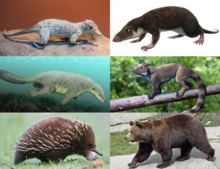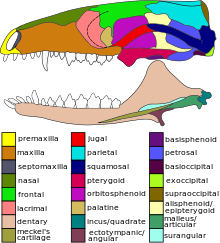| Mammaliaforms Temporal range: Late Triassic (Earliest Norian) – Present,
| |
|---|---|

| |
| Top: Megazostrodon rudnerae, Morganucodon watsoni (Morganucodonta); Middle: Castorocauda lutrasimilis (Docodonta), Shenshou lui (Haramiyida); | |

| |
| Skull of Morganucodon | |
| Scientific classification | |
| Domain: | Eukaryota |
| Kingdom: | Animalia |
| Phylum: | Chordata |
| Clade: | Synapsida |
| Clade: | Therapsida |
| Clade: | Cynodontia |
| Clade: | Prozostrodontia |
| Clade: | Mammaliamorpha |
| Clade: | Mammaliaformes Rowe, 1988 |
| Subgroups | |
| |
Mammaliaformes ("mammalian forms") is a clade that contains the crown group mammals and their closest extinct relatives; the group radiated from earlier probainognathian cynodonts.[1] It is defined as the clade originating from the most recent common ancestor of Morganucodonta and the crown group mammals; the latter is the clade originating with the most recent common ancestor of extant Monotremata, Marsupialia, and Placentalia.[2] Besides Morganucodonta and the crown group mammals, Mammaliaformes includes Docodonta and Hadrocodium.[3][4]
Mammaliaformes is a term of phylogenetic nomenclature. In contrast, the assignment of organisms to Mammalia has traditionally been founded on traits and, on this basis, Mammalia is slightly more inclusive than Mammaliaformes. In particular, trait-based taxonomy generally includes Adelobasileus and Sinoconodon in Mammalia, though they fall outside the Mammaliaformes definition. These genera are included in the broader clade Mammaliamorpha, defined phylogenetically as the clade originating with the last common ancestor of Tritylodontidae and the crown group mammals.[2] This wider group includes some families that trait-based taxonomy does not include in Mammalia, in particular Tritylodontidae and Brasilodontidae.
Animals in the Mammaliaformes clade are often called mammaliaforms, without the e. Sometimes, the spelling mammaliforms is used. The origin of crown-group mammals extends back to the Jurassic, with extensive findings in the Late Jurassic outcrops of Portugal and China. The earliest confirmed specimens of fur are found in them, demonstrating that the ancestors of mammals had already developed fur.
- ^ Abdala, F. (2007). "Redescription of Platycraniellus Elegans (Therapsida, Cynodontia) from the Lower Triassic of South Africa, and the cladistic relationships of eutheriodonts". Palaeontology. 53 (3): 591–618. Bibcode:2007Palgy..50..591A. doi:10.1111/j.1475-4983.2007.00646.x. S2CID 83999660.
- ^ a b Rowe, T. S. (1988). "Definition, diagnosis, and origin of Mammalia" (PDF). Journal of Vertebrate Paleontology. 8 (3): 241–264. Bibcode:1988JVPal...8..241R. doi:10.1080/02724634.1988.10011708.
- ^ Cite error: The named reference
LuoMartinwas invoked but never defined (see the help page). - ^ Datta, P. M. (2005). "Earliest mammal with transversely expanded upper molar from the Late Triassic (Carnian) Tiki Formation, South Rewa Gondwana Basin, India". Journal of Vertebrate Paleontology. 25 (1): 200–207. doi:10.1671/0272-4634(2005)025[0200:EMWTEU]2.0.CO;2. S2CID 131236175.